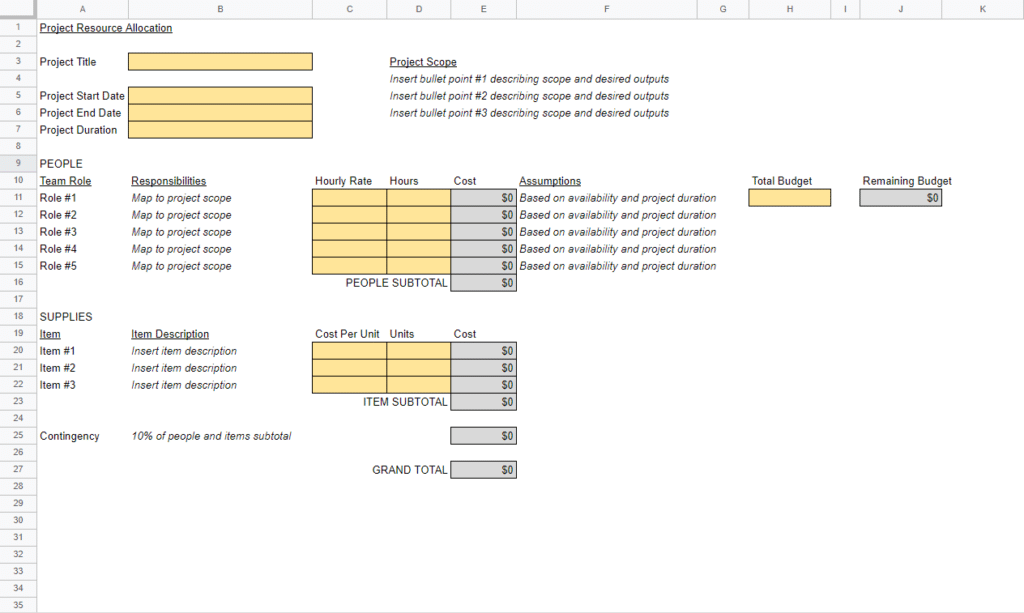Having the right resource allocation, with the right team members working on the right things, is vital for your project’s success.
Yet, many project managers still struggle with this, and 60% of allocated resource skills and capabilities don't actually support project or business goals. This resource allocation guide and template will help you achieve project success.
What Is Resource Allocation?
Resource allocation is a process in project management that involves assigning and distributing project resources needed to complete projects on time successfully.
As part of the broader resource management process, project managers allocate their people's and other resources' skills and capabilities to execute project tasks and milestones on time and meet deliverables.
Resource allocation is best managed in resource management software or specific resource allocation software.
How To Allocate Resources
If you're a project manager, you understand the importance of strategic planning and having an effective and efficient resource allocation strategy to navigate resourcing challenges—which is often easier said than done. You also know resource management tools are essential for efficiency.
Ensuring you can effectively allocate the right resources to the right tasks at the right time starts with these resource allocation process steps first to get you on the right path.
1. Determine Scope & Required Resources
Before allocating and assigning resources, you must define your project objectives, deliverables, workflow, project timelines, and stakeholders to identify the necessary resources. These could include human resources, equipment, technology, and financial assets. Proper planning at this stage will help in efficient resource allocation.
Then, you'll have to break your project down into smaller tasks and allocate resources accordingly. This also means taking stock of your people's skills, capabilities, and other needed resources. Proper resource planning and setting the stage right the first time will streamline resource allocation and execution.
2. Determine Resource Availability
Once you have identified the required resources, the next step is to assess available resources.
Multiple projects may be on the go, and your required resources may already be allocated elsewhere. These resources must be available to you when needed throughout the project life cycle.
Estimating the resources required for each task gives you an accurate view of resource availability ahead of schedule. If resources aren't available when needed, it can delay your timeline and increase your budget, jeopardizing your entire project scope. Identify any constraints or limitations that may affect the allocation process.
Resource planning and availability example: If your company is launching multiple products and marketing campaigns, the marketing team may need more resources to service all of them simultaneously.
As a project manager, it's vital during project planning to discuss the scope of your project resourcing needs and the timing of those resources rather than planning based on assumptions and crossing your fingers.
3. Schedule & Assign Resources To Tasks
After assessing resource availability, you can schedule and assign resources to specific project tasks. Create a detailed plan or schedule that outlines the allocation of resources over the project duration. Consider your team members' skills, expertise, and availability when assigning tasks.
Distribute resources in a way that ensures a balanced workload and optimizes productivity. Scheduling is a crucial part of resource management, ensuring everyone knows who's working on what and who's available.
It also enables informed decision-making and avoids overcommitting or underutilizing resources, which might lead to bottlenecks and team burnout.
Resource scheduling example: If you have a few rock star performers on your project team, you might be tempted to assign them a much heavier workload than others. Resist overallocation. Often, this leads to burnout, resentment, and higher turnover. Your best resources need to be allocated—not over-allocated if you plan to keep them performing optimally.

4. Track Utilization & Capacity
You can only know when you'll be there if you know where you are.
Once you've assigned resources, monitoring and tracking their utilization in real-time is essential to ensure efficiency. You should regularly review and assess how resources are utilized and adjust as needed—and there's almost always a need to do this.
Track and document resource capacity to avoid overloading individuals or teams. This will help you identify blockages, reallocate resources if necessary, and maintain optimal productivity levels without overburdening them.
Utilization and capacity example: If you're launching an app and aren't tracking resource utilization and capacity, how can you identify how well your resources are performing, whether they are on track for your app launch, or whether it will be launched on time or within scope?
Accurately tracking your resources throughout your projects is the only way to map where your team is in the process, where things are going, and whether your project will be successful.
5. Re-evaluate & Adjust As Needed
It's important to remember that resource allocation is an ongoing process that requires continuous evaluation and adjustment.
As projects progress and circumstances change, you must re-evaluate resource allocation and adjust accordingly. Remain flexible and adaptable to optimize resource utilization and address any challenges or changes that will arise—and they will arise.
Ensure you look at all of the factors that impacted your resource allocation. Then, re-evaluate and adjust based on these factors and dependencies in your project that may now be unbalanced. Remember that as resourcing changes, it impacts the cost of your project and delivery timelines, among other things.
Some examples of change include your resources not being available or when you need them. The project's scope may change and compromise previous resource allocation decisions.
Resource Allocation Methods
There are various methods that organizations can use for resource allocation. The methods you choose will depend on your focus and end goals. Let's explore some of the most common resource allocation methods:
- Critical path method (CPM) is a preemptive strategy for keeping a project within time constraints. CPM calculates a project's earliest and latest possible start and finish times.
- Critical chain method (CCM) resulted from CPM, with a few key distinctions. CPM creates a project schedule based on task dependency, while CCM alters the schedule to consider resource limitations. Therefore, it can be used independently or in conjunction with the CPM.
- Resource leveling allows project managers to modify the project schedule, including the start and end dates, based on the availability of resources to reduce demand and protect workers from overcommitment that can lead to burnout.
- Resource smoothing minimizes the demand for resources while staying within time constraints. Project managers can modify resource scheduling to get the job done.
Benefits of Resource Allocation
Effective resource allocation offers numerous benefits for organizations. Let's explore some of the key advantages:
- Enhanced productivity: This ensures your resources can work optimally to achieve the desired project outcomes.
- Reduced waste: Doing this saves your company money for other initiatives.
- Improved resourcing clarity: Having more visibility into your resourcing helps ensure everyone is on the same page.
- Increased morale: This is an important element in reducing increasing performance and buy-in and decreasing absenteeism and turnover.
- Decreased turnover: Resource availability increases when your projects experience lower turnover rates.
- Increased project success rates: Increased resource efficiency leads to higher success rates and improved project profitability and ROI.
Challenges with Resources Allocation
While resource allocation is crucial for maximizing efficiency, it can also come with its fair share of challenges. Here are some common ones:
- Skill sets and capability shortages: As people come and go, resource allocation options are disrupted, and the potential for risks is opened up.
- Skill and leadership gaps: Project leadership and team skills gaps can compromise project requirements and timelines.
- Scope creep: As situations or customer needs change, scope creep can develop. This leads to the need for scope changes—including resource allocation changes.
- Conflicting priorities: Politics and power struggles often lead to conflicting priorities and miscommunication, making allocating resources challenging.
- Poor project support: Sometimes, your project might fall lower on the priorities list, reducing the chance of your resource budget being approved or adequate.
- Budget constraints: Limited project budgets often impact how many resources you have to complete your projects successfully.
Resource Allocation Spreadsheet Template
Busy project managers like you recognize the need for automation. You need the best resource management software for exceptional project performance and the desired results.
Having a resource allocation template can also help you create clarity and visibility for everyone. From the start of your project to completion, you and your team can monitor and track resources and keep things on track.
This resource planning Excel spreadsheet makes your resource allocation planning and execution much easier!

Quick tips for using the resource management Google Sheets template:
- Make A Copy for each of these before you can download them.
- Formatting: cells shaded in yellow (e.g., project start date) require your input; cells shaded in gray auto-calculate based on the information you enter.
- Adding team resources: Insert additional rows above the subtotal rows.
- The assumptions column: Use this to track whether human resources are full-time.
- The resource plan sets contingency at 10%. If you'd like to use a different percentage, adjust the formula.
- Use the template's "Remaining Budget" counter to track the project budget.
What’s Next?
Want to connect with other digital project managers to share resources and best practices? Join our membership community and get access to 100+ templates, samples, and examples, and connect with 100s of other digital project managers in Slack.


